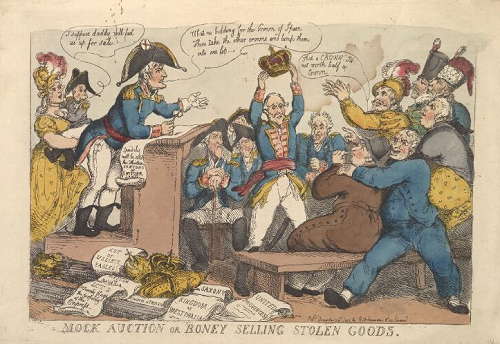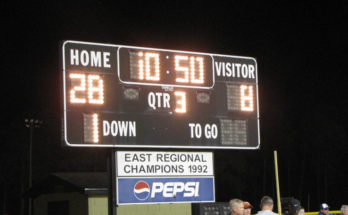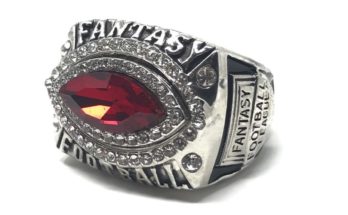Congrats on doing an auction draft league! You are significantly upgrading your fantasy football experience. Auction versus snake draft is like watching football when your fantasy players are in the game versus watching football with no investment at all. It’s like eating a perfectly medium-rare ribeye steak versus eating a well done hamburger. It’s like injecting heroin versus chugging diarrhea medicine for the opioids, which is apparently a thing people are doing, now.
But getting used to the fantasy football auction format can be intimidating. There’s definitely a steep uptick in the learning curve going from “just pick the player I want” in snake drafts to “I am involved with literally every player” in auctions. However, a few simple pieces of fantasy football auction advice can get you up to speed.
First, an argument using ethos, to establish my credibility. There are a lot of “Intro to Fantasy Football Auction” and “Fantasy Football Auction Advice 101” guides out there, so why did I even bother to write one? The answer is simple: All the other auction guides are wrong. I love my fellow fantasy pundits, and I seek their insightful advice every day. However, their focus is primarily on snake drafts because that drives most of the traffic. So when they are given an assignment of covering auction, they rely on the few auctions they do every year, usually with the same people, and try to apply that advice to every auction. They do this despite it flying in the face of their own commonly-given advice that “every auction is different,” because they need to crank out an auction article to get hits.
Not me. I live to auction. My leagues are almost exclusively auction. I’ve done hundreds, with a variety of people from friends to pundits to extremely inebriated comedians. August sees me constantly in a mock auction every minute of every day. My lovemaking has been horrible.
The proof of my auction obsession can be seen in the fact that, if you search for “2019 fantasy football auction values,” our small, humble site’s auction rankings consistently come up in the top 5 hits, some weeks we’re even #1. People go to those rankings because it gives them something none of the other site’s rankings do: Auction values based on the strange and unique nature of auctions.
Now that I’ve optimized SEO, let’s get into the list:
6 Easy Tips for Becoming Great at Auctions
1. Do a Mock Auction
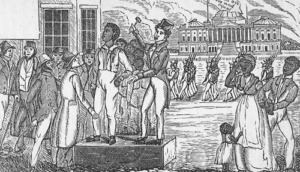 Google Images taught me that fantasy football
Google Images taught me that fantasy football
has been around longer than I thought.
Here, I assume, are people bidding on what
appears to be a change-of-pace running back
The format is what intimidates most people who have never auctioned. It’s actually quite streamlined, but is a bit more complex than snake draft. Each turn goes like this:
– Whoever’s turn it is nominates a player
– People bid on that player with a fixed budget (usually $200)
– Highest bid wins the player.
That’s it. Simple, right? It usually only takes newbies about 10 minutes of a mock before they are comfortable with the format and interface.
I like using the mock auction on Yahoo or ESPN. Although, I’m always looking for new mock auctions that fill up with real people, to broaden my auction data, so if you’ve got another site you like please comment.
Now that you’ve done a mock and understand the format, here are some easy-to-follow tips for success. Bonus: There are a lot of bad tips out there that some of your fellow owners will probably be following, so you’re already ahead of them.
2. Get a Couple of Great Players you Love

I love Christian McCaffrey even more than this
This is the beauty of auction, you aren’t forced into selecting guys based on where you fall in the draft order. Do you think Dalvin Cook is all healed up and going to dominate? Get him. Are you a Giants fan who loves rooting for Saquon Barkley? Get him. Are you convinced that Damien Williams has real talent and could become a top 5 RB? You’re an idiot, but get him.
By “get him,” do I mean enter into a bidding war until they are way past their recommended value?
Put simply: Yes. If that makes you uneasy, a general rule of thumb for a top-15 overall ranked player is 10% over recommended value. So if David Johnson is recommended for $55, you can feel confident going as high as $61. However, even that’s not hard and fast if you truly love a player. Last year I was starry-eyed for Christian McCaffrey. His recommended auction value was around $45, but I would often bid into the mid-$50s, about 20% higher. He was a top 2 RB that year and is going for mid-$60s now in 12 team leagues, and I got to spend an entire season ecstatically cheering him on in many of my leagues.
The thing to take away from this is: You can’t count on value for a top 15 player. They almost never go for recommended auction value or lower and, if they do, your league is probably bad at auction and you can dominate regardless of how tightly you adhere to these strategies. Just get the guys you want to root for, and make up the value with the less-appealing mid-round guys who fall for a steal.
3. Don’t Spend All Your Money on 3 High-End Players

Which is better: A lot of pretty good candy
or 3 amazing jellybeans?
There’s a reason why I said get “a couple” of great players. 2 is a fine number. 1 will do if you really like a lot of the guys going in rounds 3-5 and want to fill your team with them. But spending upwards of $160+ dollars on three players will leave the rest of your fantasy team struggling.
Sadly, this is a popular strategy espoused by many fantasy football writers. It’s called “Stars and Scrubs.” The theory is that a lot of cheap players emerge as winners, so why not anchor your team with proven studs and then sift through the pile of $1-$5 players?
My answer is as simple as it is aggressive: A lot of times that just doesn’t work, Pollyanna. Sometimes it does, which is why many fantasy pundits think it’s a viable strategy: They did it in their once-yearly auction so it must work all the time. Zero-RB snake draft strategy sometimes works, but fantasy writers rarely say, “you never want to draft an RB before round 6,” because a lot of times it won’t work.
Stars and Scrubs is like spending your entire paycheck on a new TV, speakers, and a Nintendo Switch, then hoping it doesn’t get too hot because you can’t afford air conditioning or water. Sure, it works sometimes, but it’s not a good idea.
What does work all the time is getting 1-2 top 15 players then spreading the rest of your budget around to get a nice balance of medium players. Speaking of which…
4. Save a Starting Spot for a Wide Receiver Steal

Not Pictured: Calvin Ridley.
Because he’s inside that bag
If you look at WRs ranked 15-30, there’s not a lot of difference, this year. Some people like Dante Pettis more than Tyler Lockett or Kenny Golladay, yet Pettis is 10+ spots behind those guys in rankings. More than ever, a WR2 will go for about half off their recommended value, somewhere in the $5-$15 range. Owners aren’t excited enough to open their wallets, and many of them have filled their WR and even Flex spots before all the WR2 candidates have been nominated.
Take advantage of this lack of demand to wait on your second wide receiver until one falls for at least 50% off, usually more. In every mock I’ve done this year across multiple platforms, I’ve gotten a WR that was recommended in the $15-$25 range for under $10, sometimes under $5. While typing this I got Calvin Ridley (auction recommendation: $17-$22) for $7.
This is the safety “valve” that allows you to over spend for those top 2 players you love, you make it up in WR2 value.
5. Nominate Costly Players You Don’t Want
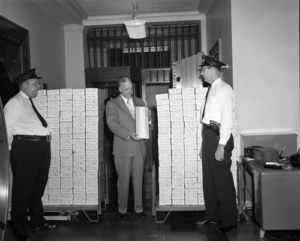
The right early nomination will eat up money
faster than, well, probably that guy on the left
Whether auctioning online or in person, you should have a list of players with some sort of auction ranking by recommended dollar value. Your goal on nominations should be to get as much money out of the pot with a guy you hate. You want to pick one from slighty down the list because usually most owners nominate people from the top of the list, so any players you hate from the top of the list will probably get nominated soon anyway.
I like nominating Todd Gurley and Damien Williams early. I don’t like them, they are going for about $35-$45, and they don’t usually get nominated until towards picks 20-30. Not only does this get a sizeable chunk of an owner’s budget out of future potential bidding wars, it fills up someone’s RB1 slot, making them less likely to want to overpay for an RB1 I actually do want.
In the middle rounds I still nominate people I don’t want, but I tend to target positions with scarcity over players that might fetch a high dollar value. If I don’t get a top 3 tight end, I start nominating a highly ranked TEs that aren’t OJ Howard or Evan Engram. I really want those guys and I don’t like any other tight end, so by nominating guys like Eric Ebron I significantly reduce the demand another owner has for tight end. Think about it: If an owner paid $12 for Ebron, are they going to want to get in a bidding war for Engram?
It’s such a basic economic concept: Reduce the demand for players you want and the supply of money available for other people to bid on players you want. Yet I constantly see auction advice columns that advocate other strategies, like:
– Nominate a player you want early, before the market value is set
This is another one of those “hey it worked sometimes in my limited number of auctions, so I’ll advise people to do it every time” fallacies. Yes, sometimes you can sneak a player out there and all 11 other owners will totally forget they have an auction sheet in front of them telling them exactly what a player is worth.
But most of the time, it doesn’t happen that way. Think about it: All it takes is ONE other owner to really like a top player you like, and they’ll bid more than market value. Considering the early rounds see many owners with a lot of money left to spend, it’s not a good play.
Also consider this: Other owners are nominating players, too. So if there is a deal to be had by nominating a good player before the market is set, there’s a good chance another owner will do it for you. Meanwhile you keep systematically whittling away at the demand for good players and the supply of money and get the best of both worlds.
– Nominate the most expensive player remaining, to get the most out of the pot
This is another one of those good ideas that other owners will execute for you. Owners want to bid on great players early, when they have the money, so most will be nominating players from the top of the list. Meanwhile you’re going a little lower on the list to get back-end RB and WR1s onto people’s rosters, making them less likely to want to really push up the bidding on the top tier guys.
– Nominate a kicker or defense for $1 early.
I see this a shocking amount of time, both in fantasy auction advice columns and in actual auctions. Frankly, it’s really stupid. The thought process goes like this “if no one bids, I get a kicker/defense I wanted, and if another owner bids then that’s a dollar out of the pot.” The logic is sound, but it can be done on a much larger scale: If getting a dollar out of the pot is good, then getting $30-$45 out of the pot by nominating a RB/WR you don’t want must be dozens of times better. Also, if you really care that much about getting a specific kicker or defense, just bid $2 on them when they get nominated. It’s only an extra dollar or 0.5% of your total budget, who cares?
6. Save $10-$20 for your bench
 A cheap bench can’t support 6 NFL players.
A cheap bench can’t support 6 NFL players.
That’s just simple physics.
In the later rounds of auction, $2 bids are king. Many owners will stretch themselves out making their starting lineup and have only $1 left for bench players. This means that they have to wait until it’s their turn to nominate, pick a guy they want, then wait to see if any other owner who actually has money left wants them (and they usually do). Having the funds to bid $2 every time a guy you want gets nominated gives you 12x the chances of getting a good bench player than the $1 owner gets, because you can bid on every nomination whereas those with just $1/bench slot left can only get players when they nominate them.
That’s it: The 6 simple tips to transform yourself from auction noobie to auction veteran. Once again:
1. Do a mock to learn the format
2. Get 1-2 top 15 players you really love
3. Don’t blow your budget on 3 top 15 players
4. Save some room in your starting lineup for a wide receiver steal
5. In the first 5 or so rounds, nominate players you hate that are about 10-15 spots from the top of the list. After that, nominate players you hate in a position you still need until you reach the rounds when $1-$5 bids are enough to win. Then nominate players you want
6. Save $10-$20 for your bench
If you were on the fence about auctioning, I hope this convinces you that it can be easy to get into. I can’t convey how much fun it is, too, you have to experience it for yourself.
